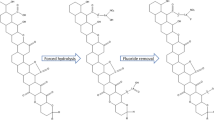Abstract
The Lewis acid transformation to Bronsted acid was investigated over the Pt/γ-Al2O3 hybrid catalysts in the presence of hydrogen atmosphere by in situ diffuse reflectance infrared Fourier transform spectroscopy (DRIFTS) of adsorbed NH3. The changes of FTIR spectra were monitored during the introduction of hydrogen at 40 °C and atmospheric pressure for 130 min. The degrees of Lewis acid transformation were varied by addition of non-reducible (SiO2 and Al2O3) and reducible (ZrO2, TiO2 and CeO2) oxides to the Pt/γ-Al2O3 catalysts as the hybrid catalysts. According to the in situ DRIFTS, the hydrogen temperature programmed reduction (H2-TPR), and the hydrogen temperature programmed desorption (H2-TPD) results, the introduction of hydrogen resulted in a decrease in the amount of ammonia adsorbed on Lewis acid sites, and an increase in the amount of ammonium ions on Bronsted acid sites with time on stream. It is proposed that ammonia migration from Lewis acid sites to Bronsted acid sites occurred during the introduction of hydrogen in the presence of Pt particles when compared to the observation of only observed catalysts (without Pt particles). The addition of reducible oxides led to the high rate of Lewis acid transformation, which was higher than those of the non-reducible oxides. Weaker Lewis acid sites and higher amount of hydrogen spillover over the observed catalysts enhanced the rate of Lewis acid transformation in this study. However, the amount of Lewis acid sites at the initial stage did not play an important role in these transformations.








Similar content being viewed by others
References
Corma A (1995) Inorganic solid acids and their use in acid-catalyzed hydrocarbon reactions. Chem Rev 95:559–614
Wang P, Zhang W, Zhang Q, Xu Z, Yang C, Li C (2018) Comparative study of n-butane isomerization over SO4 2–/Al2O3-ZrO2 and HZSM-5 zeolites at low reaction temperatures. Appl Catal A 550:98–104
Song C, Chu Y, Wang M, Shi H, Zhao L, Guo X, Yang W, Shen J, Xue N, Peng L, Ding W (2017) Cooperativity of adjacent Brønsted acid sites in MFI zeolite channel leads to enhanced polarization and cracking of alkanes. J Catal 349:163–174
Han W, Nie H, Long X, Li M, Yang Q, Li D (2017) Effects of the support Brønsted acidity on the hydrodesulfurization and hydrodenitrogention activity of sulfided NiMo/Al2O3 catalysts. Catal Today 292:58–66
Choi S-W, Kim W-G, So J-S, Moore JS, Liu Y, Dixit RS, Pendergast JG, Sievers C, Sholl DS, Nair S, Jones CW (2017) Propane dehydrogenation catalyzed by gallosilicate MFI zeolites with perturbed acidity. J Catal 345:113–123
Lee W, Lee T, Jang H-G, Cho SJ, Choi J, Ha K-S (2017) Effects of hierarchical zeolites on aromatization of acetylene. Catal Today 303:177–184
Ebitani K, Tsuji J, Hattori H, Kita H (1992) Dynamic modification of surface acid properties with hydrogen molecule for zirconium oxide promoted by platinum and sulfate ions. J Catal 135:609–617
Hattori H, Shishido T (1997) Molecular hydrogen-originated protonic acid site as active site on solid acid catalyst. Catal Surv Asia 1:205–213
Ohgoshi S, Nakamura I (1993) Hydrogenation of isobutylene by spiltover hydrogen from Pt/KA-zeolite to NaY-zeolite. Stud Surf Sci Catal 77:289–292
Khoobiar S (1964) Particle to particle migration of hydrogen atoms on platinum—alumina catalysts from particle to neighboring particles. J Phys Chem 68:411–412
Ceckiewicz S, Delmon B (1987) Cooperative action of Pt/gamma-Al2O3 catalyst and gamma-Al2O3 diluent in the hydrogenation of benzene. J Catal 108:294–303
Ueda R, Tomishige K, Fujimoto K (1999) Promoting effect of hydrogen spillover on pyridine migration adsorbed on Lewis acid sites in USY zeolite. Catal Lett 57:145–149
Chen C-H, Huang C-C (2008) Enhancement of hydrogen spillover onto carbon nanotubes with defect feature. Microporous Mesoporous Mater 109:549–559
Shin H, Choi M, Kim H (2016) A mechanistic model for hydrogen activation, spillover, and its chemical reaction in a zeolite-encapsulated Pt catalyst. Phys Chem Chem Phys 18:7035–7041
Prins R, Palfi VK, Reiher M (2012) Hydrogen spillover to nonreducible supports. J Phys Chem C 116:14274–14283
Prins R (2012) Hydrogen spillover. Facts and fiction. Chem Rev 112:2714–2738
Im J, Shin H, Jang H, Kim H, Choi M (2014) Maximizing the catalytic function of hydrogen spillover in platinum-encapsulated aluminosilicates with controlled nanostructures. Nat Commun 5:3370
Barzetti T, Selli E, Moscotti D, Forni L (1996) Pyridine and ammonia as probes for FTIR analysis of solid acid catalysts. J Chem Soc Faraday Trans 92:1401–1407
Hegarty MES, O’Connor AM, Ross JRH (1998) Syngas production from natural gas using ZrO2-supported metals. Catal Today 42:225–232
Nakagawa K, Ikenaga N, Teng Y, Kobayashi T, Suzuki T (1999) Transient response of catalyst bed temperature in the pulsed reaction of partial oxidation of methane to synthesis gas over supported rhodium and iridium catalysts. J Catal 186:405–413
Vorakitkanvasin S, Phongsawat W, Suriye K, Praserthdam P, Panpranot J (2017) In situ-DRIFTS study: influence of surface acidity of rhenium-based catalysts in the metathesis of various olefins for propylene production. RSC Adv 7:38659–38665
Mapes JE, Eischens RP (1954) The infrared spectra of ammonia chemisorbed on cracking catalysts. J Phys Chem 58:1059–1062
Duan Y, Wang J, Yu T, Shen M, Wang J (2015) The role and activity of various adsorbed ammonia species on Cu/SAPO-34 catalyst during passive-SCR process. RSC Adv 5:14103–14113
** T, Yamaguchi T, Tanabe K (1986) Mechanism of acidity generation on sulfur-promoted metal oxides. J Phys Chem 90:4794–4796
Paál Z, Menon PG (1983) Hydrogen effects in metal catalysts. Catal Rev 25:229–324
Liu C, Li X, Wang T (2015) Catalytic hydrogenation of isophthalonitrile (IPN) over supported monometallic and bimetallic catalysts. RSC Adv 5:57277–57285
Acknowledgements
The authors would like to thank the SCG Chemical Co., Ltd. for the financial support of this project.
Author information
Authors and Affiliations
Corresponding author
Rights and permissions
About this article
Cite this article
Guntida, A., Suriye, K., Panpranot, J. et al. Comparative Study of Lewis Acid Transformation on Non-reducible and Reducible Oxides Under Hydrogen Atmosphere by In Situ DRIFTS of Adsorbed NH3. Top Catal 61, 1641–1652 (2018). https://doi.org/10.1007/s11244-018-0995-1
Published:
Issue Date:
DOI: https://doi.org/10.1007/s11244-018-0995-1




